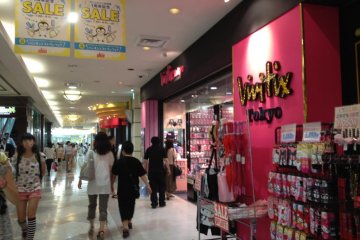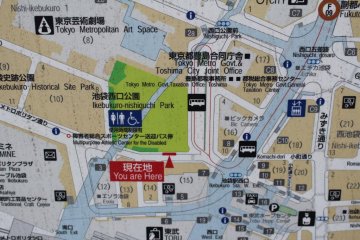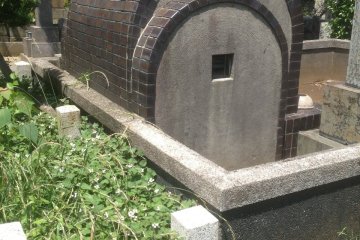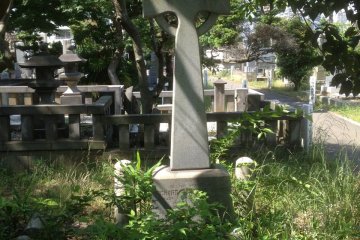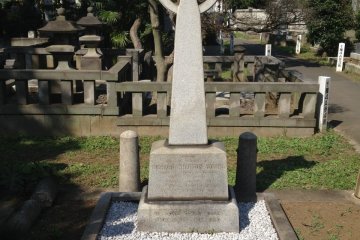When it comes to parks and greenery, Ikebukuro seems to have been dealt a poor hand. However, looked at from another perspective, in eastern Ikebukuro there is a spacious 10 hectare (approx. 25 acre) "park" with an abundance of peace and quiet, many trees as well as some interesting historical facts. A stroll through the Zoshigaya Cemetery is both relaxing and informative.
In Japanese, the word "cemetery" has two quite different meanings. The first and most common term is "bochi". Bochi are small; Buddhist only; affiliated to an adjacent temple or nearby temples; and gated. They may or may not have rest rooms, or other amenities.
The second term "reien" is translated as "spiritual garden" or "spiritual park". Reien are large (Aoyama Reien is 26 ha, while Tama Reien is 126 ha!); open to all religions (though, in practice, primarily Buddhist with some Christian graves); public roads go through them; there are restrooms, vending machines, benches, shops for flowers and incense etc., and many trees. In addition, there are maps, and reien have a numbered grid to help you find a specific location. For some reason, famous people (actors, writers, artists et al) tend to have a memorial in a reien. This is not to say that everyone in a reien is a celeb.
One thing that both bochi and reien share is that the overall atmosphere is very intriguing. In life, it is safe to say that most Japanese are conformist. In death, however, a good deal of individuality is often expressed in the graves. They vary in size. Some have stone lanterns, miniature torii gates, river rocks, pieces of lava, mausoleums and so on. Many have "sotoba", long wooden sticks with the deceased's posthumous name written on them. In addition, some tombstones have etchings - cherry blossoms and Mt. Fuji are common. But if someone had particularly liked golf, cats or driving this would be reflected in the headstone. And lastly, there are the various offerings: flowers, of course, both real and artificial. Plus a can of beer, a bottle of water and so on is often placed on a headstone as a refreshment gift. Contrast this with the row upon row of crosses or the cookie cutter headstones in typical Western cemeteries.
Zoshigaya Reien was established in 1874 and now has 9,000 "guests". I'm sure you will enjoy the space, the open sky and the silence. Explore the paths and appreciate the diversity of the graves. I see something new and interesting on each visit.
You never know what you'll find. Once, while wandering around, I discovered an overgrown memorial: Major Richard Wharton Boger (1866-1910) "Royal Artillery Military Attache to the Britannic Majesty's Embassy". His epitaph was:
if love could save
thou hadst not died
I still find it to be very moving. I contacted the British Embassy. They hadn't known about Boger's grave and in a short time it was given the attention it deserved. (1-4A-5 in the Zoshigaya grid)
Other people of note
- Nakahama "John" Manjiro (1827-1896), 1-15-1
One of the first Japanese to visit the U.S. He had a very interesting life. At the age of 14, in 1841, he was shipwrecked while fishing. Rescued by an American ship, he was taken to Hawaii and then went to Boston. After many adventures, he returned to Japan in 1851. This was very risky because Japan, at the time, was in "sakoku" (self-imposed isolation) and death was the penalty for returning from overseas. Remarkably, Nakahama's overseas experiences were appreciated. This was just before Commodore Perry's Black Ships arrived in July, 1853. Among other things, Nakahama returned to America in 1860, studied in Europe in 1870, and became a professor at the Tokyo Imperial University. - Koizumi Yukumo (Lafcadio Hearn) (1850-1904), 1-1-8
Arrived in Japan in 1890, taught at Tokyo Imperial University 1986-1903; became a professor at Waseda in 1904. Hearn wrote knowledgeably and introduced Japan to many Westerners through his books. - Ogino Ginko (1851-1913), 1-5-23
The first licensed and practicing woman physician of Western medicine in Japan. She had style! - Hani Motoko (1873-1957) 1-1-10
Japan's first female newspaper reporter, who was editor and publisher of Fujin no Tomo (Woman's Friend), Japan's longest-surviving woman's publication, and co-founder of Jiyū Gakuen, a private, co-educational school (designed by Frank Lloyd Wright and which can be found in West Ikebukuro) - Tojo Hideki (1884-1948), 1-1-12
A general of the Japanese Imperial Army, and Prime Minister 1941-1944; executed for war crimes by the International Military Tribunal for the Far East.
If you are interested in discovering more, check out this link for English language information about the graves of all the famous people at Zoshigaya.




